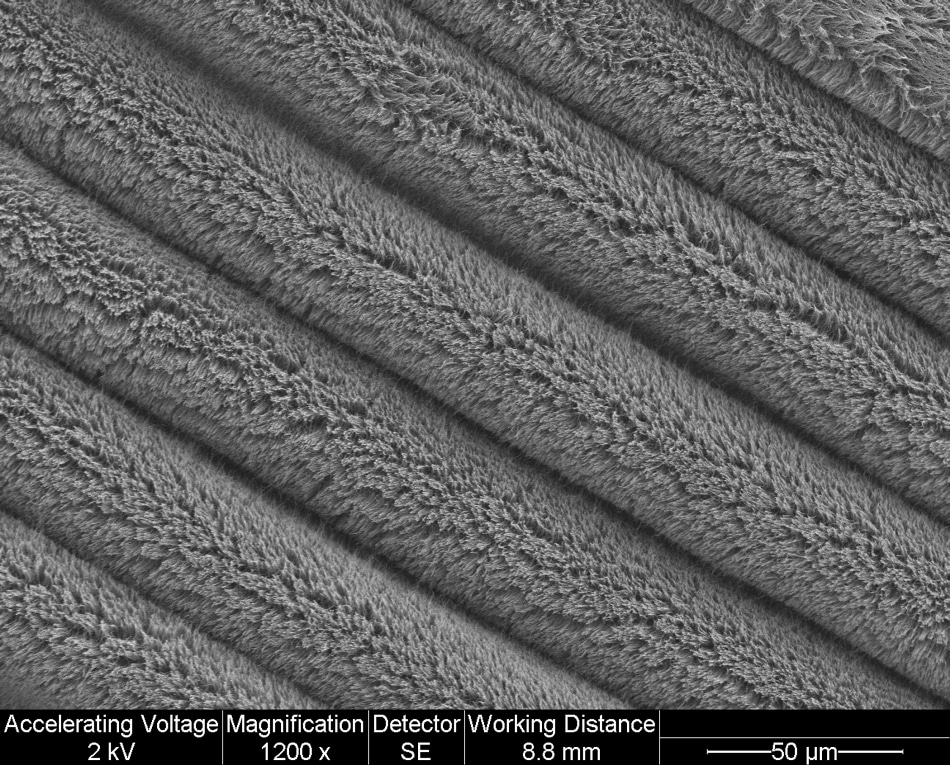May 3 2019
Better power sources are required for the advancement of emerging wearable tech. Now, at Michigan State University (MSU), a research team has offered a promising solution through crumpled carbon nanotube (CNT) forests.
 For emerging wearable tech to advance, it needs improved power sources. Now researchers from MSU have provided a potential solution via crumpled carbon nanotube forests, or CNT forests. (Image credit: MSU)
For emerging wearable tech to advance, it needs improved power sources. Now researchers from MSU have provided a potential solution via crumpled carbon nanotube forests, or CNT forests. (Image credit: MSU)
Director of MSU’s Soft Machines and Electronics Laboratory, Changyong Cao headed a research team in producing highly stretchable supercapacitors that can be used to power wearable electronics.
The supercapacitor, which was designed recently, has shown excellent stability and performance, even upon stretching to 800% of its original size for a countless number of relaxing and stretching cycles.
The results of the team have been reported in the journal, Advanced Energy Materials. The study can potentially lead to the development of implantable biomedical devices, novel stretchable energy electronic systems, and even smart packaging systems.
The key to success is the innovative approach of crumpling vertically aligned CNT arrays, or CNT forests. Instead of having a flat thin film strictly constrained during fabrication, our design enables the three-dimensionally interconnected CNT forest to maintain good electrical conductivity, making it much more efficient, reliable and robust.
Changyong Cao, Director, Soft Machines and Electronics Laboratory, Michigan State University.
A majority of people are aware of wearable technology in its fundamental form as iWatches that have the ability to interact with smartphones. In this case, there are a couple of pieces of technology that require batteries. Now, envisage smart skin patches for burn victims—patches that can track healing and, at the same time, power themselves—that’s the future that can be created by Cao’s latest invention.
In the field of medicine, wearable and stretchable electronics are being created that can conform to uneven and intricate surfaces and are capable of extreme contortions. In the days to come, innovations like these can possibly be incorporated into biological organs and tissues to identify disease, track improvement, and also interact with medical practitioners.
However, a complementary wearable power source has been the vexing problem. One that is durable and can last for a long time. Therefore, the question, at this juncture, is why should cool new patches be developed if they merely need to run off huge battery packs that become hot and need recharging? (while that is extreme, one can get the idea.)
Cao’s invention is the first to employ crumpled standing CNTs for use in stretchable energy storage. These CNTs develop like trees with their canopies twisted on wafers. Conversely, this forest has a height of just 10-30 µm. Once the CNT forest is transferred and crumpled, it forms striking stretchable patterns, similar to a blanket. Moreover, the larger surface area of the 3D interconnected CNT forest can be easily adapted to other kinds of designs or can be changed with nanoparticles.
It’s more robust; it’s truly a design breakthrough. Even when it’s stretched up to 300% along each direction, it still conducts efficiently. Other designs lose efficiency, can usually be stretched in only one direction or malfunction completely when they are stretched at much lower levels.
Changyong Cao, Director, Soft Machines and Electronics Laboratory, Michigan State University.
Cao is also an assistant professor in mechanical engineering and electrical and computer engineering.
With regards to its potential to gather and store energy, the crumpled nano-forests developed by Cao outpace many other supercapacitors based on CNTs and which are known to exist. Although the leading performing technology can tolerate an innumerable number of relaxing and stretching cycles, there is more room for improvement.
Within the crumpled CNTs, metal oxide nanoparticles can be effortlessly impregnated so that the efficiency of the invention enhances even more. Cao added that the recently discovered method should trigger the development of self-powered stretchable electronic systems.
Co-authors who participated in this research are Yihao Zhou, Philemon Henry, Jeffrey Glass, and Charles Parker of Duke University; Stephen Ubnoske of the U.S. Naval Research Laboratory; Yunteng Cao of Massachusetts Institute of Technology; and Jianfeng Zang of Huazhong University of Science and Technology (China).
The study was partly funded by the National Science Foundation and the United State Department of Agriculture.